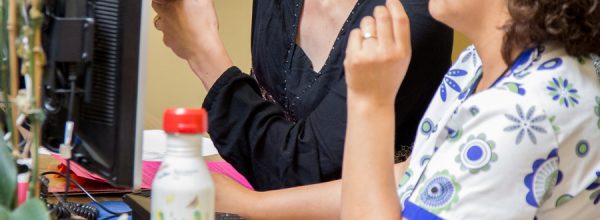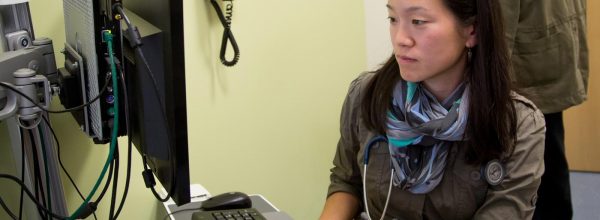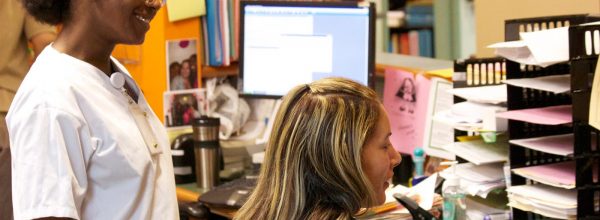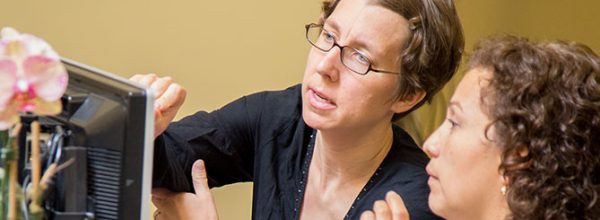Electronic health records (EHRs) come with lots of advantages, but for many doctors they are also a burden. Organizations across the country have experimented with using “scribes” to take on the task of navigating and filling out patient records during or after an exam. At Southeast Health Center in San Francisco, a program to train scribes for the city’s safety net clinics yielded some valuable insights on how best to manage and use this burgeoning clinic role.
Why Scribes?
For doctors, many of whom were trained to fill out paper charts by hand, meticulously clicking through long and sometimes unintuitive EHR screens can be a major factor that contributes to provider burnout. A 2013 RAND study found that while most doctors approve of EHRs in principle, the new systems were a significant source of physician dissatisfaction, with providers citing “poor usability, time-consuming data entry, interference with face-to-face patient care, inefficient and less fulfilling work content, inability to exchange health information, and degradation of clinical documentation.” American EHRs are particularly complex because they organize documentation more to support billing processes than care processes. Scribes do the work of recording exam findings and care plans in the EHR system, leaving doctors free to focus on engaging with patients.
Building a Training Hub
The scribes program at Southeast Health Center (SEHC), part of San Francisco Department of Public Health, is more than just another pilot; it has become a hub to train scribes to serve at clinics throughout the city’s safety net. SEHC developed a two week training course for scribes involving shadowing and mock exam sessions. SEHC has sent its scribes to work in eight of the fourteen SFGH health centers, including Potrero Hill, Maxine Hall, and Castro Mission. These scribes rotate through these clinics and return to SEHC to ensure they don’t pick up bad habits at a particular clinic and maintain a unified gold standard for the system.
The Start of a Career
Unlike some other scribe programs which use volunteers, the SEHC program pays its scribes and uses the role to cultivate young professionals entering the health field. The program’s founder, Dr. Keith Seidel, medical director at SEHC, argues that paid scribes are easier to train, manage and hold to a high standard than unpaid volunteers. Pay also makes the role more attractive to medical students, nursing students or public health researchers, for whom working as a scribe can offer a transformative view of how primary care is delivered in a community clinic. Seidel views the scribes program as more than just another facet of refining the care team; it’s a form of workforce development that gives those starting a health career an early chance to experience a chance to work with the most vulnerable in our society. And because the training period for scribes is efficient and relatively short, losing these individuals to their eventual career advancement does not cause undue care team disruption. In fact, the attentive work of a scribe is best suited for individuals who don’t plan to stay in the role forever, and thus do not become complacent. Upwardly mobile scribes are good at working out kinks in the system, or even offering insight into how doctors do their work.
Insights and Best Practices
- The job of the scribe is to summarize what happens in the exam room in the EHR without distracting either patients or doctors. To this end scribes should be like “ninjas”: quiet and able to fade into the background.
- Early on in their training, new scribes will often try to record everything that is said between the doctor and patient, but this will often result in significant amounts of extraneous information in the record. Effectively training the scribes will help scribes learn how to summarize histories in the record.
- Untrained scribes may also try to be helpful by clicking ahead through the EHR form to save time (clicking “normal” on a number of irrelevant questions, for instance). But in doing so they may miss what is actually happening in the room.
- When intending to use a scribe during an exam, doctors should not be too deferential about asking patient permission. If asked directly if they would like to have a scribe sit in on the exam, most patients will decline. But if doctors enter the exam room with their scribe and simply explain that the scribe will be taking notes, patients rarely object.
- After a scribe completes an exam note, a doctor must check the work before locking it and submitting orders for prescriptions or tests. Doctors should then give daily feedback, pointing out errors. Scribes improve with daily feedback from providers.
- Doctors should have a platform for providing anonymous feedback on scribes to managers. SEHC set up a “Yelp-like” system for doctors to review and rate scribes.
- Some doctors are harder to scribe for than others. Some providers may also be resistant to working with a scribe, even if they themselves struggle with the EHR. SEHC found it best to require that doctors work with a scribe.
- Doctors should be required to work one day per week without scribes. This keeps them from becoming dependent on the help, and helps them maintain an appreciation for the work the scribes do.
- Scribes should continually rotate from one provider to another, to make sure that neither scribe nor doctor becomes dependent on working with a single individual. This is perhaps the biggest difference between SEHC and other scribes systems. This “emergency room” model creates a standardized workforce that allows scribes to be deployed and interchanged, within a clinic or across multiple clinics, as staffing needs shift from day to day.
- Even though they aren’t tied to an individual provider, scribes should, if possible, be colocated with doctors in office space for completing EHR notes and building strong relationships. SEHC even holds regular social gatherings, such as “providers versus scribes” bowling or minigolf, to help build comraderie and partnership.
Advantages in the Exam Room
Though the original goal was to reduce the time doctors spend in front of computer screens and clicking through the EHR, the program has found that very act of including a scribe in the exam conversation actually encourages patients to engage more in their care. Without scribes, many doctors will normally make silent notes about exam findings (when glands are swollen, what symptoms they find significant, and so forth) before pronouncing a diagnosis. But when doctors speak their findings out loud for a scribe to record, the patient also hears them, and can offer explanations, related information (“now that you mention it…”), and other insights. Patients know their own bodies even if they don’t always understand the medical implications of what they are experiencing; knowing what the doctor finds noteworthy can unlock diagnostically valuable information—and improve health literacy. Further, scribes can help doctors remember all the topics they had planned to discuss with the patient, such as bringing up resources for smoking cessation or social services. Scribes can even call up relevant health records for the doctor to organically refer to during the exam conversation, without having to make a distracting detour to the computer.
Results
SEHC found that using scribes yielded significant gains in provider satisfaction and productivity. Using an evaluation developed by the UCSF Center for Excellence in Primary Care, SEHC found that providers using scribes were significantly more likely to be satisfied with individual exam visits and to stay on schedule during a patient encounter. The scribes program increased the volume of patients doctors could see by an average of 1.8 per doctor per half-day session. As a result, providers were better able to leave the clinic on time when using a scribe. Providers also felt that the quality of their notes increased when using a scribe, and found that they had more time to devote to other care improvement initiatives, such as population health management. The scribes, meanwhile, reported feeling comfortable, satisfied and useful in their role.
What’s Next?
SEHC is currently searching for funding sources to continue supporting and advancing their scribes training program. In the meantime, they have expertise they are willing to share with other health centers looking to start their own scribes program.
Learn More
- Southeast Health Center, located in the Bayshore neighborhood, is a part of the San Francisco Department of Public Health. Founded in the 1970s and taken over by the city in the 1980s, SEHC has 4800 patients on register. It’s patient population is 60% African-American, and 25% monolingual Spanish-speaking.
- Download the CEPC toolkit SEHC used to evaluate their program.







